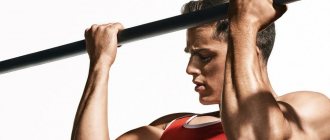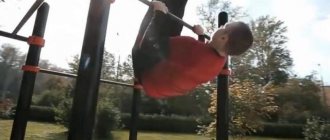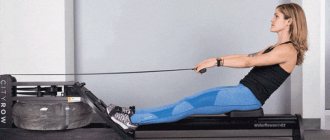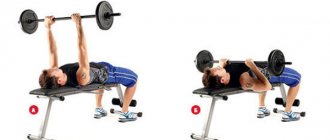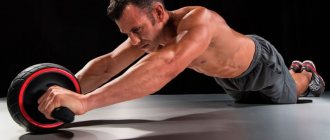Every novice athlete, sooner or later, wonders how to create a training program on their own. To create a competent training program, it is enough to follow simple rules, which will not be difficult to master. It will take much more time to use these rules to choose a truly effective training program that is suitable for you. Since there is no universal program for all occasions, you will have to take time to try different approaches and observe how your body reacts to them.
If we talk in general terms about what the process of strength training is, then we can say that it is a series of constant destruction and restoration. In the process of training, whether training at home or in the gym, we damage muscle fibers. When we sleep, muscle fibers repair and thicken. In this way, our body prepares for less muscle damage next time. In order for muscles to have the opportunity to recover, we must eat properly, providing the body with all the necessary elements.
So, the right training program should provide a good load on the body and sufficient time for muscle recovery after this load. We will achieve the first by doing strength exercises, while the second is achieved by rest after training and proper nutrition. As we can see, a truly effective workout is not just a set of exercises performed in the gym. This is also discipline and adherence to a certain regime, since truly noticeable results can only be achieved by training on an ongoing basis. You will have to change your schedule, build regular workouts into it, rest well, and monitor your diet and diet. Only in this case, after a long time, the result will be noticeable - that very athletic body that you will want not only to show to others, but also to admire it yourself in front of the mirror!
Selection of exercises
First of all, you need to figure out the load, which exercises should be performed in the gym. Indeed, there are a great many exercises: these are ordinary exercises with dumbbells and barbells, which can be performed at home, and many different exercise machines that help us perform exercises in the gym more concentratedly and safely. We will not go into details and consider any specific ones. Once you start exercising, you will quickly acquire your favorite machines and exercises. A much more important point is not exactly what exercises you perform, but how you complete them, how exactly the exercises are distributed across training days, what needs to be trained in one workout and what in another, which muscles to work at the beginning and which at the end of the workout.
There are three basic rules that can be followed when distributing exercises between training days. Basically, these rules are used to fill the training program with exercises.
Top bottom
The legs are the largest muscle group in our body. Therefore, there is an opinion that these muscles should generally be given a separate training day. This is also facilitated by the fact that the hamstrings and quadriceps belong to different push-pull groups, which makes it possible to train them simultaneously without any problems. Among other things, there is also an opinion that muscles such as biceps and triceps do not need to be trained separately at all, since they already receive enough load when performing exercises on the chest and back. Guided by these rules, we can conditionally divide our body into the upper part: back, chest and lower part - legs, and train these parts alternately. Although it is generally accepted that this scheme is more suitable for beginners to train two days a week when moving from a fullbody system to a split system, the same scheme can be used by already experienced athletes in an intensive four-day training program. An example would be the following distribution of muscle groups by training day:
- Chest, back, shoulders
- Legs, abs
Pull - Push, synergists
The thing is that our muscle groups can be divided into pulling and pushing. Pulling groups include: back, biceps (biceps brachii), biceps femoris (biceps femoris). Pushing muscles include: chest, deltoids, triceps (triceps brachii), quadriceps (quadriceps femoris), calves. The essence of the rule is not to train muscles from the same group in one workout. This can be explained using the example of the back and biceps. These muscles belong to the same group “Pulling” and the biceps are also involved in many back exercises. It turns out that if you first perform an exercise on the back, and after that an exercise on the biceps, it will be ineffective, since the biceps have already worked to help the back. Performing an exercise on the biceps, and then an exercise on the back, is also not the best option, since the biceps, already tired after its exercise, will not allow you to completely perform the exercise on the back, because it will fail first. To prevent this from happening, it is customary not to include muscles from one group in one workout. As an example, we can consider a three-day training program with the following distribution of muscle groups by training days:
- Chest, biceps
- Back, triceps
- Legs, shoulders
Antagonists, bend - unbend
In this case, the muscle groups should be divided into flexor and extensor muscles. The point here is that our muscles often “walk in pairs” and perform opposite movements when working. Thus, some bend the joints, others straighten them. These pairs of muscles are called antagonists. An example is the biceps, which is responsible for flexing the arm at the elbow joint, and the triceps, which is responsible for extending the arm. The same situation is in the case of the legs: the biceps of the thigh flexes, and the quadriceps extends the leg at the knee. When you perform an exercise on a certain muscle, the opposite antagonist rests or is in slight static tension. Thus, following this rule, muscle groups can be distributed among training days according to the principle of working them in pairs, for example:
- Chest, back
- Legs, shoulders
- Hands, abs
All at once or all separately
Undoubtedly, the easiest way is to either train everything at once in one workout or train each group separately in a separate workout. The first is more suitable for completely beginner athletes, since they usually do not have much muscle mass and do not require much recovery time. Therefore, a three-day training program, with a full workout of the entire body on each training day, would be quite normal.
In the second case, we are talking about training programs for already professional athletes. On the contrary, they have large muscle mass and in order to work out their muscles well, they need to try hard. Therefore, it is not possible to train muscles together. Moreover, such a program requires a lot of free time, which in most cases those who do not do this professionally do not have.
Sequence of exercises
The effectiveness of the training process also depends on the order in which the exercises are performed during training. The muscles of our body vary in volume. The effort that needs to be spent on working it depends on the volume of the muscle; larger muscles need to be loaded more intensely. Also, the recovery time of the muscle depends on the volume of the muscle, so small muscles recover faster. Large muscles include the chest, back, and legs. Small muscles include shoulders, biceps, triceps, calves. There is a rule that recommends starting your workout with exercises for large muscles, and ending it with training smaller muscles. The logic here is that the small muscles trained at the beginning get tired and prevent the large muscles from being fully trained at the end. You should also take this rule into account when planning training days for the whole week, training according to the antagonist scheme or training everything separately. We train large muscles at the beginning of the week, and small muscles at the end.
Which muscles are best to train together?
Why is this necessary?
When we say “training schedule,” we mean “regular training 3-4 times a week.”
Imagine a muscle that is pumped to the limit every other day, in the hope of growing it faster. I don’t know about you, but if I were this muscle, I would be upset. Yes, rest is as much a part of the training process as the exercise itself. It takes 3-4 days for the muscle to recover. There are seven muscle groups in sports. Large:
• Back; • Legs/buttocks; • Chest.
Small:
• Biceps; • Triceps; • Shoulders; • Press.
Professional athletes have the luxurious opportunity to devote every day to training only one group. For beginners or simple amateurs, a daily commitment in the form of classes will not give much effect. Believe me, you need strength for more important things. And fitness is just an addition.
How to structure your workouts?
The classic and most common option is a three-day split system, designed for three strength training sessions per week. This means that during the lesson we work on one large and one small muscle group. At the end of each workout, we set aside time to work out the abs. Between classes there is one or two days of rest. There are two options for the split system:
| DAY 1 | Chest + triceps | Chest + biceps |
| DAY 2 | Back + biceps | Back + triceps |
| DAY 3 | Legs + shoulders | Legs + shoulders |
The training should begin with working out a large muscle group, and then move on to a small one. It is better to do the press at the end, because it is involved in almost all popular exercises.
Now let's look at each of these options in detail.
Option 1
On the first day we work on the pectoral muscles and triceps. Most of the exercises for these groups involve squeezing, that is, pushing the weight away from you. Thus, when doing chest exercises, we also hit the triceps quite seriously. And subsequent exercises become an isolated addition.
We devote the second day to pumping up the back and biceps. Here, on the contrary, we attract weight towards ourselves, and the biceps, as we know, participates in this movement, helping to increase the amplitude. Thus, after exercises for the back, we “pump up” the biceps.
On the third day, a different principle works. Shoulders are not involved in leg training. But this is the only day that we can devote to high-quality work with deltas without a time imbalance. The shoulders are a very important muscle group that affects overall strength as well as a harmonious appearance. Deltas consist of three beams, and to work well on each of them, you need your own exercises.
Option 2
This is a less common model. Many people believe that tiring and then “finishing off” a secondary muscle is the wrong decision. Take, for example, the chest and triceps. These are antagonist muscles. Having tired the small muscle, we are no longer able to properly pump it up in isolated exercises. This becomes especially true if you are giving 100%.
Our advice: try both complexes and choose what suits you best.
Full body workout
Many professional athletes consider this model “cheating” and say that it is only for beginners. But there is something to argue with. You don’t have to look far for an example: CrossFit training combines all muscle groups. Can anyone say that they are weaklings?
With a skillful approach, you can create a full body workout for both a professional and a simple beginner.
The essence of the idea is generally clear: we work on all muscle groups at once. Therefore, the body synthesizes a sufficient amount of testosterone, which stimulates growth.
If you do a variety of exercises, use new exercises and their combinations each time, this provides the basis for constant progress, because muscle adaptation is almost impossible. But if you constantly exercise according to one program, on the contrary, the progress of muscle growth slows down, but endurance and strength increase.
But there are also disadvantages to circular training. First of all, of course, this is increased fatigue. If you do not reconsider your attitude towards exercise in time, this will turn into psychological fatigue or overtraining.
Here, however, as in everything else, it is important to maintain your sanity and not kill yourself in vain.
When creating your program, keep in mind that not all exercises are combined with each other. For example, two popular back exercises—deadlifts and hyperextensions—are not recommended to be combined in one session. We wrote in detail about incompatible exercises in this article:
What exercises cannot be combined in one workout?
Muscle recovery between workouts
Giving your muscles a good rest is just as important as giving them a good workout. Recovery time depends on several factors that are related to muscle volume and the degree of muscle damage during training. The larger the muscle group, the more damage it receives during training, therefore, the more time it takes for it to fully recover. Another factor is the intensity of the workout. The time required for recovery will depend on how much you load your muscles while performing exercises. The harder the workout, the longer it takes to recover from it. It should also be taken into account that the recovery time for a beginner athlete will be less than for an experienced one due to the fact that he has less muscle mass.
The right training program is not just a list of exercises and going to the gym. Strength training is a way of life. Train yourself to exercise regularly. Train well, without abuse. You can't create a good body in one month, don't even try. Get plenty of rest, follow a routine, get enough sleep, and generally lead a healthy lifestyle. You'll have to work hard, but the result will be worth the effort. A beautiful strong body and a feeling of satisfaction from the work done will not take long to arrive.
In special cases, you can start with isolation exercises
In some cases, it is really advisable to start training with an isolation exercise, and not with a basic one! The main thing is that you understand why you are doing this. And you can do this for two reasons:
No. 1. To specifically (consciously) pre-tire the working muscle.
This technique is most often used only by advanced athletes (consciously).
Example: a person has weak pecs and strong triceps (typical me). Consequently, such a person can specifically tire out his strong triceps (with an isolating exercise) in order to then “break through” his pecs in the basic exercise, loading them (pumping) to the maximum. Comprendo?
In other words, we do all this crap so that strong triceps do not steal the load from the chest. That's all! For example, such a person does a barbell bench press while lying on an inclined bench, but his triceps, not his pecs, work first! As a result, they steal (steal) almost the entire load from the chest, not allowing them to grow... this is why a person can use this technique to tire out a strong chest and pump up his weak pecs)).
No. 2. To warm up/warm up the working muscles, ligaments and joints, and prepare them for more forceful work, thereby minimizing the chance of injury to the maximum.
A striking example: do an isolating exercise - seated leg extensions, with a light weight, in a large number of repetitions (20-30-40), thereby warming up the knee joints, and then move on to the basic exercise - squats with a barbell on the shoulders or bench press legs in the exercise machine.
Somehow like this. In other cases (and this is the majority), it is imperative to start training with heavy basic (multi-joint) exercises. And not everyone can finish isolating, and not everyone can finish isolating; it all depends on your training experience. In other words, beginners can concentrate only on the base, and completely eliminate any isolation. I don’t seem to be a beginner, but I still work like this)), seriously, there is no isolation at all - no!!!
More advanced (and experienced) athletes, of course, decide for themselves, however, as a rule (as practice shows) they use one, maximum 2 isolating movements at the end of the workout.
Professionals (I mean, those who are under the pharma) decide for themselves, but frankly speaking, between us, then isolation can work a hundred times better for them than the base)). I'm serious.. but this is only for those who are on pharmaceuticals, for naturals (those who do not use anabolic steroids) this will definitely not work 100%, so they need to concentrate on the base.
Sequence of muscle groups in training
For those who don’t know, there is a split in bodybuilding (this is the splitting of muscle groups on different days).
Well, for example:
- On Monday we train our leg muscles
- On Tuesday we train the chest muscles
- On Wednesday we train our back muscles
- On Thursday we train deltoids (shoulders).
- On Friday we train the arm muscles (biceps and triceps)
Do you understand? So this is what we will talk about now, you should know about the correct sequence of muscle groups on specific days, because a lot of things depend on this too.
Well, for example: if on Monday we train instead of legs -> back, and on Tuesday instead of chest -> arms = then this is very bad, because when we trained our back (on Monday) our biceps were actively working, therefore they are already tired , and here, because you don’t know the correct sequence of muscle groups on specific days, you again do biceps training….
Firstly, you won’t be able to fully train your biceps (I hope it’s clear why (because on Monday we trained your back, where the biceps worked to the fullest)), and secondly, if this continues more than once, then overtraining is not far off . Therefore, there will be no muscle growth




